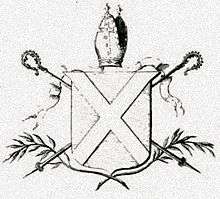St Andrews Sarcophagus

The Saint Andrews Sarcophagus is a Pictish monument dating from the second half of the 8th century. The sarcophagus was recovered beginning in 1833 during excavations by St Andrew's Cathedral, but it was not until 1922 that the surviving components were reunited. The sarcophagus is currently on display at the Cathedral museum in St Andrews, close to the site of its discovery.
Description
As originally constructed the sarcophagus would have comprised two side panels, two end panels, four corner pieces and a roof slab. The roof slab is entirely missing, as are most of one side and one end panel and a corner piece so that the extant sarcophagus is essentially L-shaped. The external dimensions of the sarcophagus are 177 cm by 90 cm and a height of 70 cm. The stone used is a local sandstone.
The surviving side panel shows, from right to left, a figure breaking the jaws of a lion, a mounted hunter with his sword raised to strike a leaping lion, and hunter on foot, armed with a spear and assisted by a hunting dog, about to attack a wolf. Although it is not certain that the first two figures represent the same person, 19th century illustrations depict them as if they are. The surviving end panel is much simpler, essentially a cross with four small panels between the arms. The fragments of the missing end panel are similar, but not identical, to the surviving one.
Discovery
The Sarcophagus was discovered within the grounds of The Cathedral near the St Regulus Chapel. The Cathedral had been in use from when it was constructed during the 1100s until it was stripped of all its altars and images, left in ruins and abandoned after 1559 during the Reformation. Much of its remaining stonework was recycled over the years into buildings in the town of St Andrews.[1]
In the course of digging a grave in 1833, workmen discovered the remaining large fragments of the sarcophagus at a depth of about 6 to 8 feet.[1] Through the years various casts of the pieces were made [1][2]but the original pieces were not reassembled until 1922.[3]
Historical opinion
Historians differ on who was likely to have been interred in the sarcophagus. Although it is generally presumed that it was commissioned by the Pictish King Óengus, or Onuist, a Christian who died in 761, whether it was actually used for his corpse,[5] for his predecessor, Nechtan mac Der Ilei,[6] or for a later personage[7] is unclear.
Notes
- 1 2 3 Buist, George (1855). Society of Antiquaries of Scotland, ed. "On the Ancient Sculptured Monument Discovered at St Andrews, in 1833 [speech given February 27, 1854]". Proceedings of the Society of Antiquaries of Scotland, Volume 1. Edinburgh: Neill & Company. 1: 234–237. Retrieved August 27, 2016.
- ↑ Foster, Sally (2016). "Expiscation! Disentangling the later biography of the St Andrews Sarcpohagus". Ancient Lives: Object, People and Place in Early Scotland. Essays for David V Clarke on his 70th birthday. Leiden: Sidestone Press: 165–186.
- ↑ Foster, Sally (1998). The St. Andrews Sarcophagus: A Pictish Masterpiece and Its International Connections. Four Courts Press. p. 41. Retrieved August 27, 2016.
- ↑ See T. M. Charles Edwards, "'The Continuation of Bede', s.a. 750: high-kings of Tara and 'Bretwaldas'".
- ↑ MacLean, Douglas. "The Northumbrian Perspective" in Simon Taylor (ed.), Kings, clerics and chronicles in Scotland, 500–1297: essays in honour of Marjorie Ogilvie Anderson on the occasion of her ninetieth birthday. Dublin: Four Courts Press, 2000. ISBN 1-85182-516-9 (pp. 200–201)
- ↑ Henderson, George & Isabel Henderson, The Art of the Picts, London: Thames and Hudson, 2004. 0-500-23807-3 (pp. 155–156)
- ↑ Clancy, Thomas Owen. Caustantín son of Fergus (Uurgust) in The Oxford Companion to Scottish History, Oxford & New York: Oxford UP, 2002. ISBN 0-19-211696-7
References
- Charles Edwards, T.M., "'The Continuation of Bede', s.a. 750: high-kings of Tara and 'Bretwaldas'" in Smyth (ed.), Seanchas, pp. 137–46.
- Foster, Sally M. (ed.), The St Andrews Sarcophagus: A Pictish Masterpiece and its International Connections. Dublin: Four Courts Press, 1998. ISBN 1-85182-414-6
- Foster Sally M.(2016) Expiscation! Disentangling the later biography of the St Andrews Sarcpohagus (Forthcoming). In: Hunter F, Sheridan A (ed.). Ancient Lives: Object, People and Place in Early Scotland. Essays for David V Clarke on his 70th birthday, Leiden: Sidestone Press, pp. 165-186.
- Henderson, George & Henderson, Isabel, The Art of the Picts: Sculpture and Metalwork in Early Medieval Scotland. London: Thames & Hudson, 2004. ISBN 0-500-23807-3
- Smyth, Alfred P. (ed.), Seanchas: Studies in Early Medieval Irish Archaeology, History and Literature in Honour of Francis J. Byrne. Dublin: Four Courts Press, 2000. ISBN 1-85182-489-8
Coordinates: 56°20′22″N 2°47′15″W / 56.3394°N 2.7875°W
